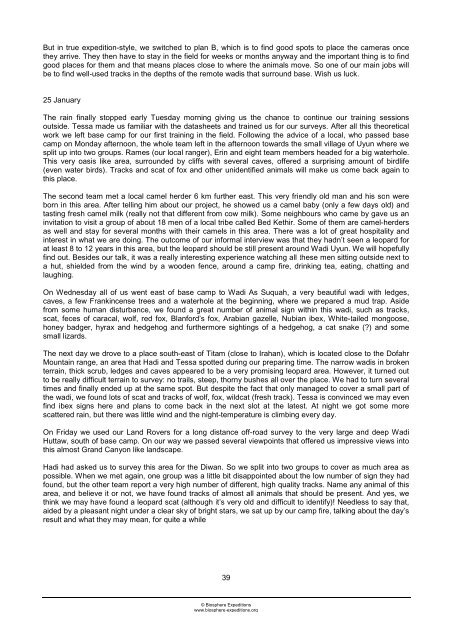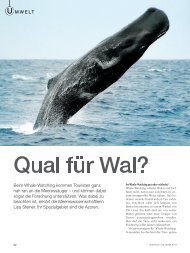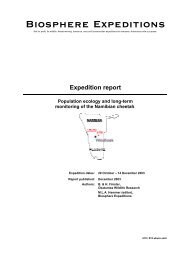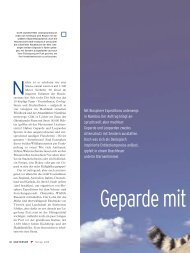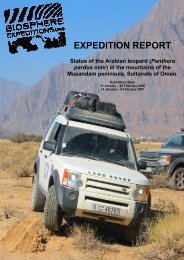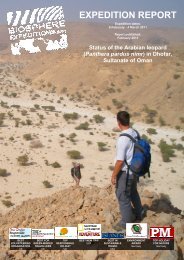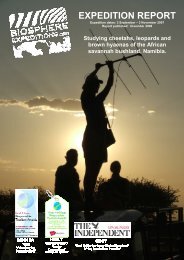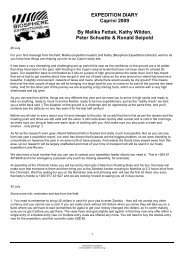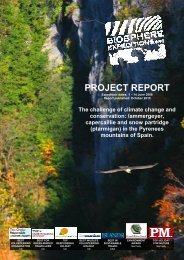EXPEDITION REPORT - Biosphere Expeditions
EXPEDITION REPORT - Biosphere Expeditions
EXPEDITION REPORT - Biosphere Expeditions
You also want an ePaper? Increase the reach of your titles
YUMPU automatically turns print PDFs into web optimized ePapers that Google loves.
But in true expedition-style, we switched to plan B, which is to find good spots to place the cameras once<br />
they arrive. They then have to stay in the field for weeks or months anyway and the important thing is to find<br />
good places for them and that means places close to where the animals move. So one of our main jobs will<br />
be to find well-used tracks in the depths of the remote wadis that surround base. Wish us luck.<br />
25 January<br />
The rain finally stopped early Tuesday morning giving us the chance to continue our training sessions<br />
outside. Tessa made us familiar with the datasheets and trained us for our surveys. After all this theoretical<br />
work we left base camp for our first training in the field. Following the advice of a local, who passed base<br />
camp on Monday afternoon, the whole team left in the afternoon towards the small village of Uyun where we<br />
split up into two groups. Rames (our local ranger), Erin and eight team members headed for a big waterhole.<br />
This very oasis like area, surrounded by cliffs with several caves, offered a surprising amount of birdlife<br />
(even water birds). Tracks and scat of fox and other unidentified animals will make us come back again to<br />
this place.<br />
The second team met a local camel herder 6 km further east. This very friendly old man and his son were<br />
born in this area. After telling him about our project, he showed us a camel baby (only a few days old) and<br />
tasting fresh camel milk (really not that different from cow milk). Some neighbours who came by gave us an<br />
invitation to visit a group of about 18 men of a local tribe called Bed Kethir. Some of them are camel-herders<br />
as well and stay for several months with their camels in this area. There was a lot of great hospitality and<br />
interest in what we are doing. The outcome of our informal interview was that they hadn’t seen a leopard for<br />
at least 8 to 12 years in this area, but the leopard should be still present around Wadi Uyun. We will hopefully<br />
find out. Besides our talk, it was a really interesting experience watching all these men sitting outside next to<br />
a hut, shielded from the wind by a wooden fence, around a camp fire, drinking tea, eating, chatting and<br />
laughing.<br />
On Wednesday all of us went east of base camp to Wadi As Suquah, a very beautiful wadi with ledges,<br />
caves, a few Frankincense trees and a waterhole at the beginning, where we prepared a mud trap. Aside<br />
from some human disturbance, we found a great number of animal sign within this wadi, such as tracks,<br />
scat, feces of caracal, wolf, red fox, Blanford’s fox, Arabian gazelle, Nubian ibex, White-tailed mongoose,<br />
honey badger, hyrax and hedgehog and furthermore sightings of a hedgehog, a cat snake (?) and some<br />
small lizards.<br />
The next day we drove to a place south-east of Titam (close to Irahan), which is located close to the Dofahr<br />
Mountain range, an area that Hadi and Tessa spotted during our preparing time. The narrow wadis in broken<br />
terrain, thick scrub, ledges and caves appeared to be a very promising leopard area. However, it turned out<br />
to be really difficult terrain to survey: no trails, steep, thorny bushes all over the place. We had to turn several<br />
times and finally ended up at the same spot. But despite the fact that only managed to cover a small part of<br />
the wadi, we found lots of scat and tracks of wolf, fox, wildcat (fresh track). Tessa is convinced we may even<br />
find ibex signs here and plans to come back in the next slot at the latest. At night we got some more<br />
scattered rain, but there was little wind and the night-temperature is climbing every day.<br />
On Friday we used our Land Rovers for a long distance off-road survey to the very large and deep Wadi<br />
Huttaw, south of base camp. On our way we passed several viewpoints that offered us impressive views into<br />
this almost Grand Canyon like landscape.<br />
Hadi had asked us to survey this area for the Diwan. So we split into two groups to cover as much area as<br />
possible. When we met again, one group was a little bit disappointed about the low number of sign they had<br />
found, but the other team report a very high number of different, high quality tracks. Name any animal of this<br />
area, and believe it or not, we have found tracks of almost all animals that should be present. And yes, we<br />
think we may have found a leopard scat (although it’s very old and difficult to identify)! Needless to say that,<br />
aided by a pleasant night under a clear sky of bright stars, we sat up by our camp fire, talking about the day’s<br />
result and what they may mean, for quite a while<br />
39<br />
© <strong>Biosphere</strong> <strong>Expeditions</strong><br />
www.biosphere-expeditions.org


